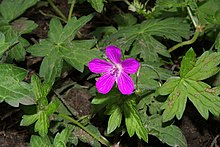Geraniales
| Geraniales | |
|---|---|
 |
|
| Geranium palustre | |
| Scientific classification | |
| Kingdom: | Plantae |
| Clade: | Angiosperms |
| Clade: | Eudicots |
| Clade: | Rosids |
| Clade: | Malvids |
| Order: |
Geraniales Juss. ex Bercht. & J.Presl |
| Families (APG IV) | |
Geraniales are a small order of flowering plants, included within the rosid subclade of eudicots. The largest family in the order is Geraniaceae with over 800 species. In addition, the order includes the smaller Francoaceae with about 40 species. Most Geraniales are herbaceous, but there are also shrubs and small trees.
The economic importance of Geraniales is low. Some species of the genus Pelargonium (Geraniaceae) are cultivated for their aromatic oil used in the perfume industry. Some other species, also mostly within Geraniaceae, have horticultural or medicinal uses. A Paleobotanic record is missing.
The botanical authority for Geraniales is given to Jussieu, but since the original description did not fulfill all the rules for a valid publication and was subsequently validly published, attribution is given to both Jussieu and the subsequent publication, hence the designation Geraniales Juss. ex Bercht. & J.Presl Jussieu, who developed the concept of botanical families, described the Gerania, as a grouping of five genera, including Geranium. Although Jussieu used the term Ordo this did not corrrespond to current understandings of the term Order. The subsequent attribution occurred in 1820, in the Czech text O Prirozenosti Rostlin, by Friedrich von Berchtold and Jan Svatopluk Presl, hence ex Bercht. & J.Presl. However, Berchtold and Presl also only described a rad (ordo) of five genera, which they called Geraniae. Other authorities have given the authority to Dumortier who described the Geraniaceae family, consisting of two tribes, Pelargonieae and Geranieae, each with three genera.
...
Wikipedia
